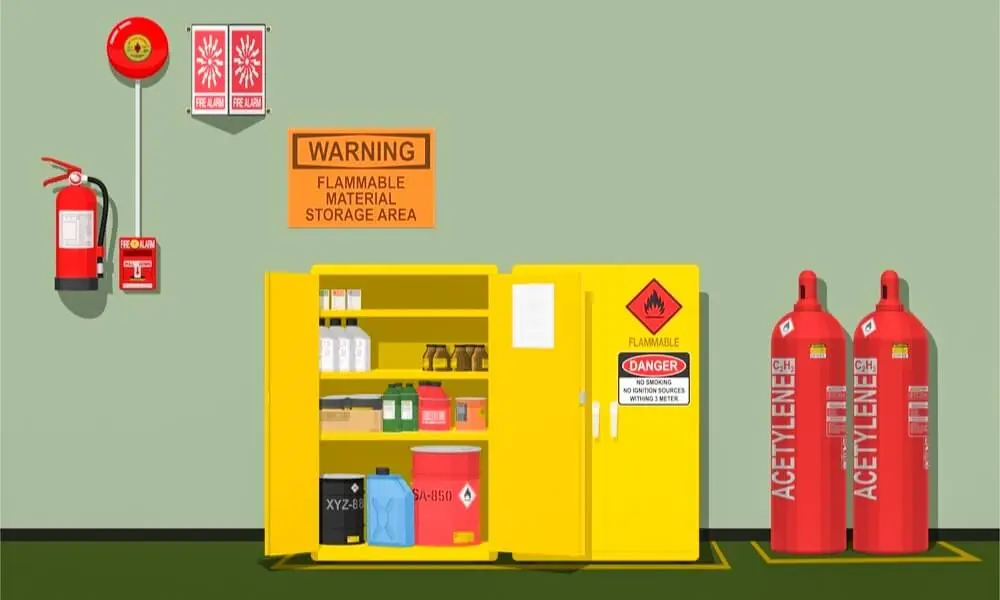Flammable materials are both an operational necessity and a potential hazard in myriad settings, from bustling laboratories to expansive manufacturing plants. These volatile substances, if mishandled, can lead to catastrophic accidents, resulting in property damage, injuries, or even loss of life. But how do industries ensure the safe containment of these materials without hindering their utility? Enter the Flammable Storage Cabinet – an unsung hero in safety management. Designed to mitigate risks and provide a secure environment for hazardous materials, these cabinets have become a staple in various sectors.
Dive into this comprehensive guide as we unravel the different types of flammable storage cabinets, explore their multifaceted benefits, and underscore their pivotal purpose in maintaining workplace safety. Whether you’re a seasoned professional or someone curious about safety protocols, this blog will shed light on the indispensable role of these specialized cabinets.
What is Flammable Storage Cabinet?
As the name suggests, flammable materials can ignite easily when exposed to open flames, sparks, or specific temperature thresholds. Common examples include certain solvents, chemicals, and fuels. Due to their volatile nature, these materials pose significant fire and explosion risks, potentially leading to property damage, injuries, or even loss of life.
Ensuring the safe storage of flammable substances is paramount. Improper storage can result in the unintentional release of fumes, increased risk of accidental ignition, or exacerbation of fire hazards in case of a fire outbreak in the vicinity. Given the inherent dangers associated with these materials, specialized containment methods are necessary.
A flammable storage cabinet is a safety cabinet designed specifically for storing flammable and combustible materials, such as solvents, chemicals, and paint. These cabinets are constructed to prevent the internal contents from catching fire, ensuring safety and minimizing the risk of fire-related incidents in laboratories, industrial settings, and other workplaces. Several key features and specifications characterize flammable storage cabinets:
- Materials and Construction: Typically made of double-walled steel with a gap of insulating air in between. Some might also have a non-flammable melamine or gypsum lining.
- Fire-Resistance: They are designed to resist fire, so if there’s an external fire, the contents inside the cabinet are protected for a specific duration, typically at least 10 minutes, allowing time for fire emergency responses.
- Self-closing and Latching Doors: Many modern cabinets have self-closing, self-latching, and tight-sealing doors. This feature ensures the cabinet remains securely closed in case of a fire.
- Ventilation: While not always required, some cabinets may come equipped with vents at the bottom and top to allow fume extraction if connected to a ventilation system.
- Grounding: Flammable storage cabinets often include a grounding connector to reduce the risk of static electricity, which could cause a spark and potentially ignite the cabinet’s contents.
- Labeling: Proper labels indicating that the cabinet contains flammable materials are crucial. This alerts workers to the potential hazard and can inform first responders in an emergency.
- Capacity: Cabinets are rated by the volume of liquids they can safely store, typically measured in gallons or liters.
- Regulatory Compliance: In many countries, the design, construction, and use of flammable storage cabinets must meet specific regulatory standards (like NFPA, OSHA, or other relevant standards) to ensure the safety of people and property.
The purpose of these cabinets is not just to prevent fires but to contain them if they do start within the cabinet. By adhering to best practices and regulatory guidelines, companies can minimize the risk of damaging fires and ensure the safety of their employees and facilities.
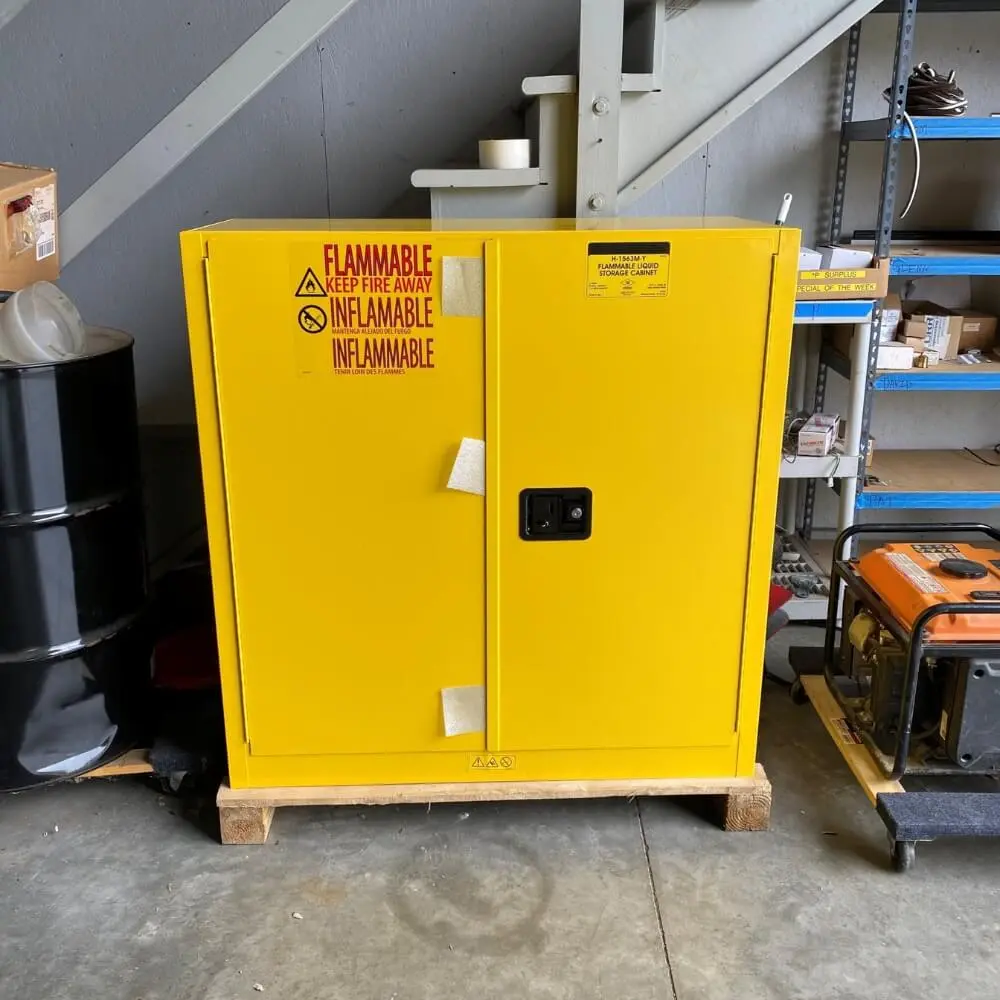
Different Types Of Flammable Storage Cabinets
Flammable storage cabinets are designed to safely store various types of hazardous materials. Different cabinets may be used depending on the specific material to store and its characteristics. Here are some of the common types of flammable storage cabinets:
- Standard Flammable Storage Cabinets: These are the most common type to store flammable liquids. They are usually yellow and have standard safety features like self-closing doors, grounding connectors, and venting options.
- Acid and Corrosive Storage Cabinets: Designed specifically for storing acids and corrosive materials, these cabinets are typically made with materials that resist corrosion. They might have polyethylene trays beneath the shelves to contain any spills. They’re often blue (though color can vary) and can be constructed from non-metallic materials or lined with a corrosion-resistant lining.
- Pesticide Storage Cabinets: These are designed to store pesticides safely. They are often green and have similar construction features as standard flammable cabinets but are distinctively labeled for pesticide storage.
- Drum Storage Cabinets: These are larger and designed to house drums containing flammable liquids or hazardous materials. Some designs even have a ramp for easier loading and unloading of the drums.
- Paint and Ink Storage Cabinets: As the name implies, these are intended for storing paints, inks, and other related products. They often have the same safety features as standard flammable cabinets but are sometimes red to distinguish them.
- Combustible Storage Cabinets: These cabinets are specifically designed for combustible materials but are not necessarily flammable. The distinction lies in the material’s flash point, with combustibles having a higher flash point than flammables.
- Gas Cylinder Cabinets: These are designed to store gas cylinders, both large and small. They can be constructed to be fire-resistant and often have chained sections to keep cylinders securely in place.
- Outdoor Flammable Storage Cabinets/Lockers: These are weather-resistant and meant for storing hazardous materials outside buildings. They typically have robust construction and ventilation and are lockable to prevent unauthorized access.
- Temperature-Controlled Cabinets: Flammable or hazardous materials must be stored at controlled temperatures in specific applications. These cabinets come with built-in temperature control systems.
- Vertical Storage Cabinets: These cabinets are taller and narrower, ideal for places with limited floor space but sufficient vertical space.
- Undercounter and Countertop Cabinets: These are designed to fit beneath counters or on top of work surfaces in laboratories or similar settings.
Remember, irrespective of the type, all these cabinets are designed to ensure the safe storage of hazardous materials. They minimize the risk of accidents and fires, protecting people and property.
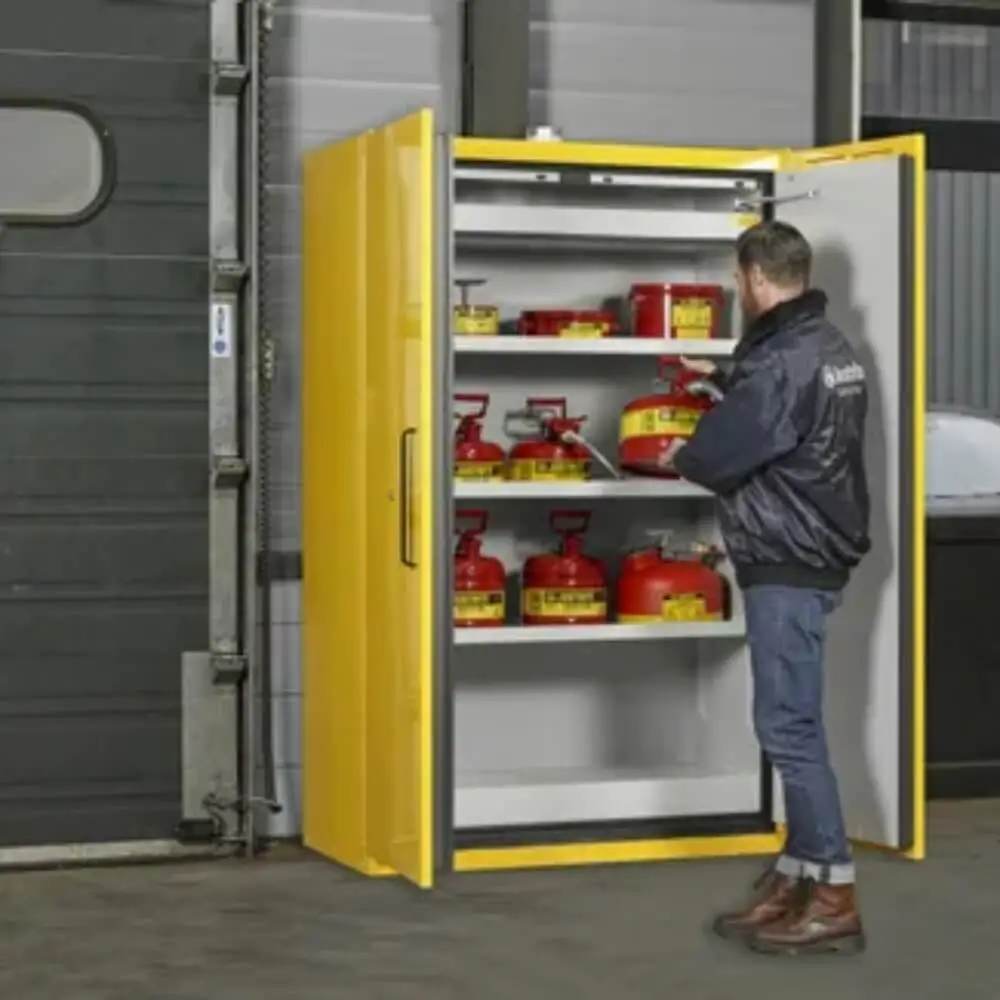
Purpose and Benefits of Using Flammable Storage Cabinets
The primary purpose of flammable storage cabinets is to provide a safe, contained environment for storing flammable and combustible materials, thereby reducing the potential risks associated with these substances. These cabinets are specifically designed to meet certain standards that prevent the initiation of a fire within the cabinet and protect the contents from external fires.
The benefits of using flammable storage cabinets are manifold:
- Fire Prevention: The materials and design of these cabinets help prevent the ignition of flammable substances inside, largely due to their ability to contain volatile fumes and minimize exposure to external sparks or flames.
- Fire Containment: If a fire does initiate inside the cabinet, its design ensures that the flames are contained, preventing the spread to the external environment. This containment provides more time for emergency response and minimizes potential damage.
- Reduced Vapor Release: Flammable materials often emit vapors that can be hazardous when inhaled and can contribute to the spread of fire. The sealed nature of these cabinets minimizes the release of these vapors into the surrounding environment.
- Organized Storage: Beyond safety, these cabinets aid in the organized storage of hazardous materials. This organization ensures that flammable substances are easily accessible when needed and safely stored away from incompatible materials or unauthorized access.
- Compliance with Regulations: Many industries are regulated by strict safety standards, which mandate the proper storage of flammable substances. These cabinets help businesses and institutions remain compliant, potentially avoiding costly fines or legal ramifications.
- Protection of Personnel: One of the most significant benefits is the protection of staff and other individuals. Safely containing hazardous materials reduces the risk of accidental exposure, inhalation, or fire-related injuries.
- Enhanced Awareness: A well-labeled flammable storage cabinet signals to everyone in the vicinity about the presence of hazardous materials, promoting a heightened sense of caution and awareness.
- Economic Savings: In the long run, using these cabinets can result in economic savings. Businesses can avoid costly damages, insurance claims, and downtime by preventing potential fire incidents.
Flammable storage cabinets are a cornerstone of safety protocols when handling and storing hazardous materials. They physically contain and protect these materials and play a vital role in creating a culture of safety and awareness in workplaces and laboratories.
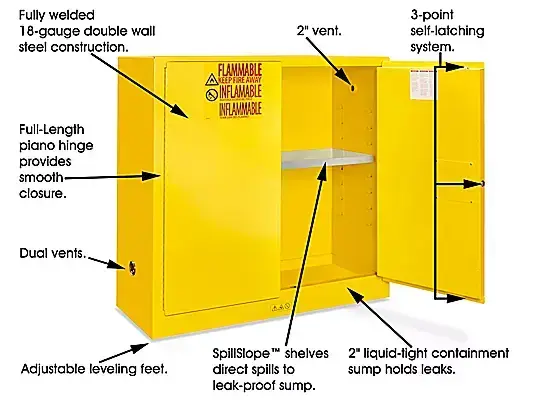
Flammable Storage Cabinets Features and Considerations
When choosing or designing a flammable storage cabinet, several features and considerations come into play to ensure safety and functionality. Here’s a comprehensive overview of the key features of these cabinets and the considerations to keep in mind:
Features of Flammable Storage Cabinets
- Double-Walled Construction: Most cabinets are constructed with double walls, usually steel, with an insulating air gap in between to offer better fire resistance.
- Self-Closing & Self-Latching Doors: This feature ensures that in the event of a fire or sudden rise in temperature, the cabinet doors automatically close and latch, sealing the contents inside.
- Leak-Proof Sill: A raised bottom sill (usually about 2 inches high) prevents spilled liquids from flowing out, aiding in the containment of potential spills.
- Venting: Some cabinets come equipped with vents at the bottom and top. This can allow for ventilation, especially if there’s a buildup of hazardous fumes, but it should be used based on specific safety protocols and local regulations.
- Grounding Connector: This feature reduces the risk of static electricity, which could cause a spark and ignite the cabinet’s contents.
- Adjustable Shelves: This help organize the storage space better and can be adjusted based on the container sizes.
- Clear Labeling: Proper labels, often in a bright yellow or red with clear ‘Flammable’ markings, alert workers and emergency responders to the potential hazard.
- Fire Resistance: The cabinet should offer resistance to fire from the outside, protecting its contents for a specified duration (e.g., 10 minutes).
Considerations When Choosing a Flammable Storage Cabinet
- Material Compatibility: Ensure the cabinet material is compatible with the stored chemicals. While steel is common, some chemicals might require a non-corroding material.
- Size & Capacity: Choose a cabinet based on the volume and number of containers you need to store. Overcrowding can impede the cabinet’s efficiency.
- Location: The cabinet should be located away from exit routes, high-traffic areas, and ignition sources. It should also be easily accessible in case of emergencies.
- Local Regulations & Standards: Different regions may have specific regulations governing the design and use of these cabinets. Familiarize yourself with local guidelines like those from NFPA or OSHA.
- Ventilation: If the cabinet is vented, ensure it’s done correctly. Improper venting can introduce more risks than benefits.
- Temperature & Environment: Consider the environmental conditions where the cabinet will be placed. If it’s in a location with significant temperature fluctuations, ensure the cabinet suits it.
- Security: In areas with higher security concerns, opt for cabinets with lockable features to prevent unauthorized access.
- Ease of Maintenance: The cabinet should be easy to clean and maintain, with the ability to quickly address spills or leaks.
In summary, when selecting a flammable storage cabinet, combining the essential safety features with practical considerations tailored to your specific needs and the nature of the flammable materials being stored is vital.
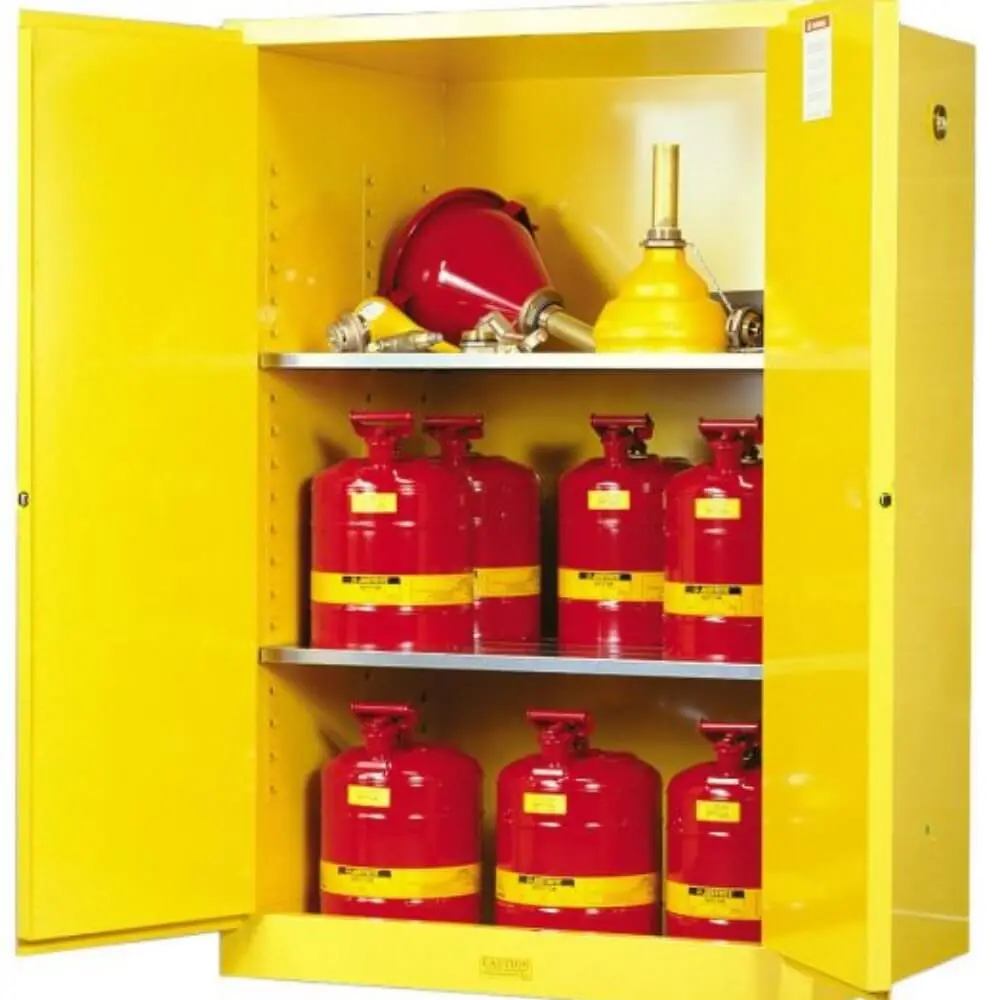
Proper Usage and Maintenance Of Flammable Storage Cabinets
Using and maintaining flammable storage cabinets appropriately ensures their effectiveness and longevity. Proper usage and maintenance guarantee safety and ensure the cabinet serves its intended purpose for a long time. Here’s a guide on the proper usage and maintenance of these cabinets:
Proper Usage of Flammable Storage Cabinets
- Correct Placement: Position the cabinet away from direct sunlight, high-traffic areas, and potential ignition sources. Also, ensure that it’s on a level, stable surface.
- Follow Capacity Guidelines: Don’t overcrowd the cabinet. Ensure you don’t exceed its rated capacity, typically measured in gallons or liters.
- Store Compatible Materials: Don’t mix incompatible chemicals, even within a flammable cabinet. This could lead to chemical reactions, leaks, or hazardous fumes.
- Ensure Proper Closure: Always close and latch the cabinet doors after use. This ensures that the contents are protected from external threats and reduces the release of potentially hazardous vapors.
- Use Grounding: If the cabinet has a grounding connector, ensure it’s properly grounded to prevent static electricity buildup.
- Avoid Modifications: Don’t make unauthorized modifications to the cabinet. Drilling holes, for example, can compromise its fire resistance.
- Label Containers: Every container within the cabinet should be clearly labeled, indicating its contents and potential hazards.
Maintenance of Flammable Storage Cabinets
- Regular Inspection: Inspect the cabinet for any signs of damage, rust, or wear. Check hinges, latches, and seals to ensure they’re functioning correctly.
- Clean Spills Immediately: If there’s a spill inside the cabinet, clean it up promptly. This will prevent potential reactions between chemicals and reduce the risk of fire.
- Check Ventilation: If the cabinet is vented, regularly check the vents for obstructions or contaminants. Ensure the ventilation system (if connected) is functioning correctly.
- Door Operation: Test the self-closing mechanism of the doors (if applicable) to ensure they close and latch automatically.
- Replace Damaged Components: If any cabinet component, like a shelf, seal, or latch, is damaged, replace it immediately. Using a compromised cabinet can be hazardous.
- Clean Exterior: Wipe down the cabinet’s exterior to remove dust and chemical residues. This helps maintain the appearance and longevity of the cabinet.
- Monitor Environment: Ensure that the environment around the cabinet remains stable. Avoid exposing it to excessive moisture, which can lead to rust, or drastic temperature changes, which might compromise its integrity.
- Review Contents Periodically: Regularly review the contents of the cabinet. Dispose of outdated or unnecessary chemicals following proper disposal procedures.
While flammable storage cabinets are designed to provide a safe environment for hazardous materials, their effectiveness depends on how they’re used and maintained. Proper care and vigilant usage ensure that these cabinets offer optimal protection against potential risks.
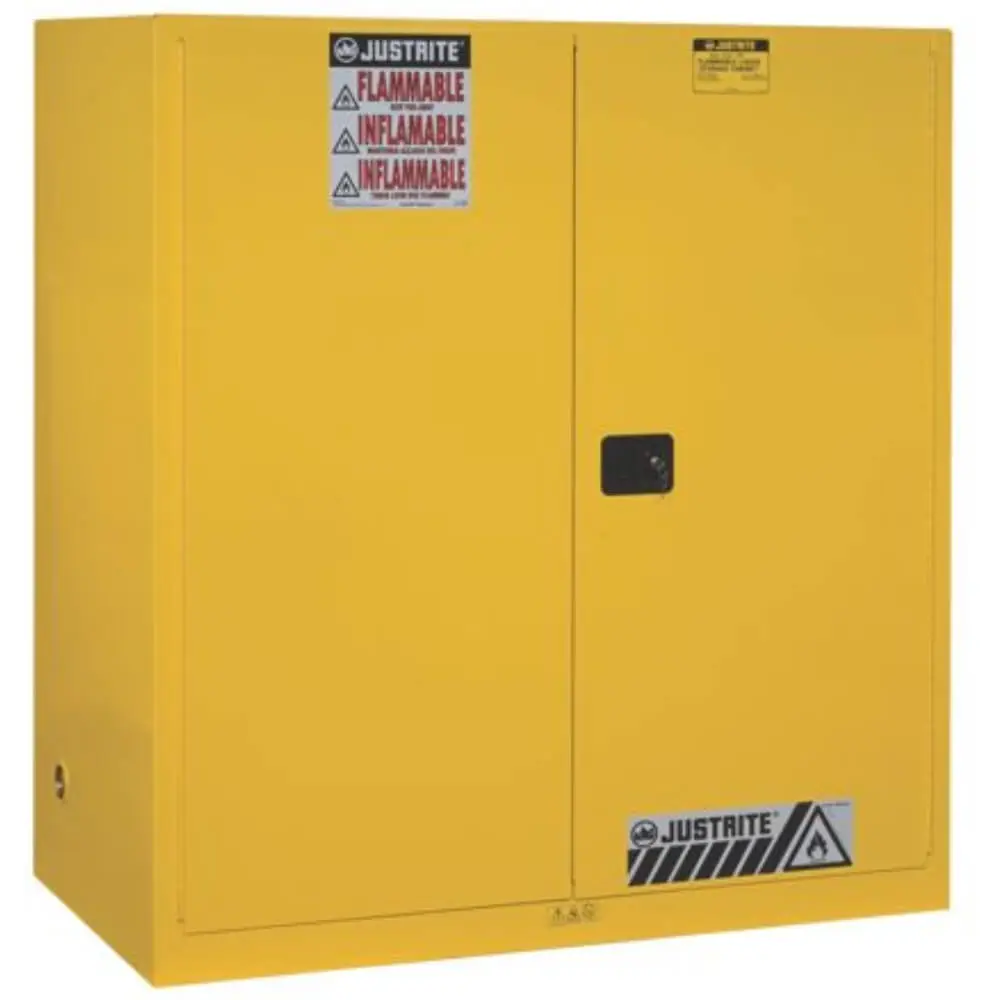
Industry Applications of Flammable Storage Cabinets
1. Laboratories
In laboratory environments, a diverse range of chemicals is used, many of which are volatile or flammable. The safe storage of these chemicals is of paramount importance for several reasons:
- Diverse Chemical Range: Laboratories often handle various chemicals, each with unique properties. Some of these chemicals can react with each other if stored improperly, leading to explosions, fires, or the release of toxic fumes.
- Volume: Even if the total volume of a particular flammable substance in a lab might seem small, the combined potential hazard of all chemicals present can be significant.
- Protection of Personnel: Laboratory technicians, researchers, and students must be protected from the harmful effects of chemical exposure, be it through inhalation of fumes or direct skin contact.
- Research Integrity: Accidental chemical reactions or fires can compromise ongoing experiments and result in data loss, resources, and time. Flammable storage cabinets ensure that chemicals remain isolated and uncontaminated.
2. Manufacturing and Industrial Settings
Manufacturing plants and industrial settings often involve processes that use flammable and combustible materials. The role of flammable storage cabinets in these environments is equally vital:
- Bulk Storage: Unlike labs that might store smaller quantities of chemicals, industrial settings might require the storage of larger volumes, amplifying the potential risks associated with mishandling.
- Operational Continuity: A fire or chemical accident can halt production, leading to downtime, loss of revenue, and, in some cases, irreversible damage to machinery and infrastructure.
- Safety Standards & Compliance: Manufacturing units are often bound by strict safety and environmental standards. Flammable storage cabinets ensure adherence to these regulations, avoiding potential legal repercussions and fines.
- Protection of Workers: Workers in these settings are routinely near hazardous materials. Proper storage is essential to reduce the risk of occupational hazards.
3. Healthcare Facilities
Healthcare facilities, including hospitals, clinics, and research institutions, often use flammable materials, especially in medical procedures or diagnostic settings:
- Patient Safety: Any accident involving flammable substances can jeopardize patient safety. Whether it’s during a surgical procedure using flammable anesthetics or in a testing lab, it’s vital to prevent any mishaps.
- Storage of Pharmaceuticals: Some drugs and pharmaceutical solutions are flammable. Proper storage ensures they remain effective and safe for patient administration.
- Medical Equipment: Many medical equipment use flammable solvents or gases for their operation. These must be stored correctly to ensure the equipment’s functionality and the healthcare environment’s safety.
- Regulatory Adherence: Healthcare facilities are tightly regulated to ensure patient safety. Proper storage of flammable materials is often required to remain compliant with health standards.
In each of these industries, the use of flammable storage cabinets underscores a commitment to safety, regulatory compliance, and operational integrity. These cabinets serve as a frontline defense against potential hazards, promoting a safer and more efficient work environment.
Conclusion
Safety remains a cornerstone in the intricate dance of industry and innovation, ensuring that progress does not come at the expense of well-being. Flammable storage cabinets stand as a testament to this commitment, offering a protective shield against the inherent risks of volatile materials. From the diverse types tailored to specific needs to the manifold benefits they bestow upon workplaces, these cabinets exemplify the balance between utility and safety.
Their purpose goes beyond mere storage; they represent a proactive approach to risk management and preserving human life and valuable resources. In understanding the nuances of flammable storage cabinets, we recognize the intricate systems that allow modern industries to thrive without compromising safety. As we forge ahead into a future of ever-evolving challenges and innovations, the foundational role of such safety measures will remain undiminished.

